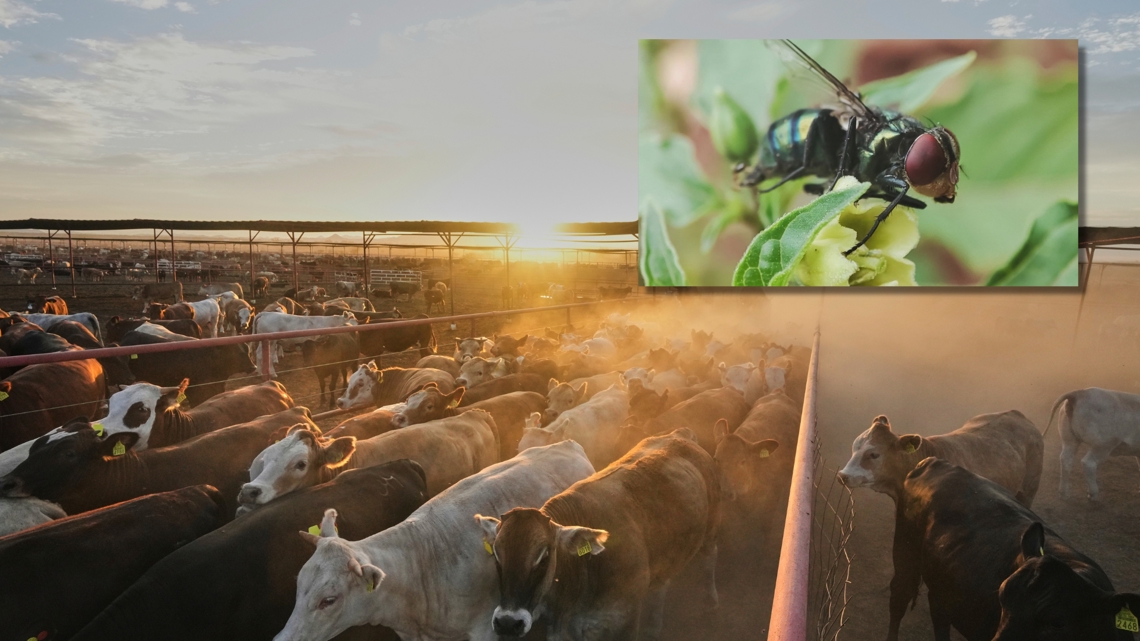
A parasite that eats live flesh has resurfaced near Texas, sparking fears for ranchers, pets and the cattle industry.
WACO, Texas — A flesh-eating parasite eradicated from Texas decades ago is now threatening to return, with the deadly New World Screwworm detected in northern Mexico just miles from the state border.
The parasite, which attacks any warm-blooded animal, including livestock, pets, and even humans, has prompted the U.S. Department of Agriculture to close the border to cattle and horse imports from Mexico as officials race to prevent a biological invasion that could devastate Texas’s $12 billion cattle industry.
Unlike ordinary fly larvae that feed on dead tissue, screwworms burrow into living flesh through open wounds, causing severe infections that can lead to death if not treated within 72 hours.
“The maggot infests the animal, it eats live flesh, and so as a result, you end up with death loss if it’s not caught early and treated,” said Tracy Tomasik, Associate Director of Commodity and Regulatory Affairs at Texas Farm Bureau. “At the bare minimum, even if you’re able to treat an infestation, you’ll lose production from an agricultural standpoint.”
Dr. Robert Judd, veterinary manager at Judd Veterinary Clinic, warns that the threat extends beyond livestock.
“The New World screwworm will attack any mammal and causes severe damage, can even lead to death,” Judd said. “Dogs and cats, certainly. Any mammal is susceptible. Even humans can be affected.”
Texas, which has more cattle than any other state, with 4.3 million head worth approximately $12 billion, is already feeling economic pressure from the threat.
The USDA’s closure of the Mexican border to livestock imports has reduced the cattle supply, raising concerns about beef shortages and market disruptions.
“We share the concern that having a smaller cattle supply by reducing those imports means we might have a shorter supply of beef ultimately,” Tomasik explained.
Kenny Mingus, who runs the Milam County Livestock Auction, says the industry is particularly worried about potential quarantine protocols.
“The biggest scare for us is the protocol that the USDA is trying … it has to do with quarantines,” Mingus said. “I don’t know really how it’s going to impact the market long term.”
Baby calves face the greatest risk, as screwworms can attack through umbilical cords immediately after birth.
“If you don’t get a baby calf doctored within seventy-two hours, that calf’s chance of life is very small because the fly will land on the naval area and infect the naval cords,” Mingus warned.
Warning signs and what to do
Animal owners should watch for these warning signs:
- Animals acting irritated or shaking their heads excessively
- Open wounds with a distinctive smell of decaying flesh
- Visible maggots in wounds
What to do if you suspect screwworm infestation:
- Put on gloves before examining wounds
- Contact your veterinarian immediately
- Call the Texas Animal Health Commission
- Collect larvae in alcohol for testing if instructed
“Clean the wound very well, collect the larvae, get all the maggots out. Your veterinarian really needs to get involved,” Dr. Judd advised.
Last Friday, Agriculture Secretary Tom Vilsack announced a major breakthrough in the fight against screwworms: a $750 million investment to build a new sterile fly facility in South Texas.
The facility will produce millions of sterile male flies that will be released to mate with wild females, causing them to produce sterile offspring and eventually breed the population out of existence.
“The female only mates once, so if it mates with a sterile male, they’ll have sterile offspring or eggs that are laid, so ultimately they don’t hatch and they end up breeding themselves out of existence,” Tomasik said.
However, the new facility won’t be operational for two to three years, leaving Texas vulnerable during that critical period.
Currently, surveillance traps are positioned along the Texas-Mexico border to detect the first signs of screwworm crossing into the state.
“It’s on the doorstep of southern Texas right now. Vigilance is key,” Tomasik said.
The Texas Animal Health Commission is leading surveillance efforts for livestock, while Parks and Wildlife manages the wildlife response. Pet owners are responsible for working with veterinarians to develop protection plans.
Officials stress that early detection and rapid response will be critical if screwworms do cross the border.
